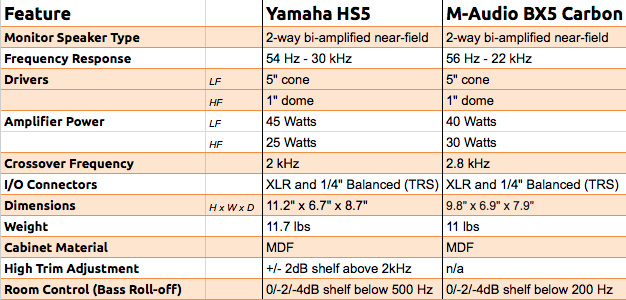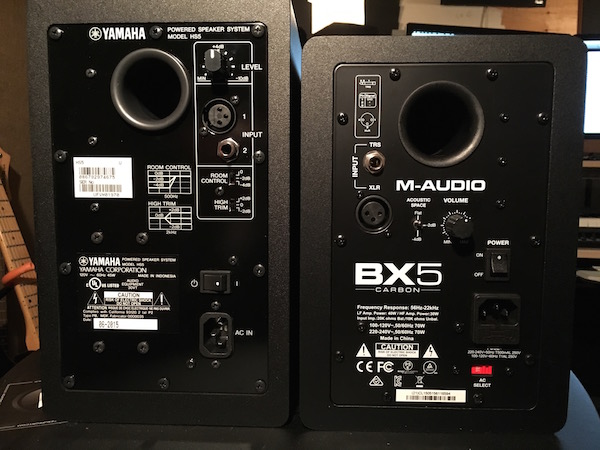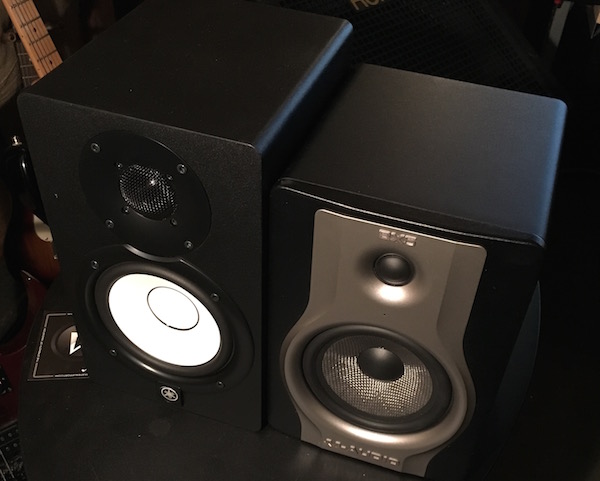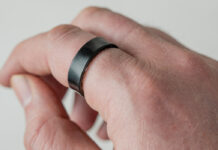 Whether someone likes or dislikes a studio monitor is obviously at the whim of personal preference. In fact, that can be said of pretty well every piece of gear in a studio. It all comes down to how that gear works for you and the results you get with it.
Whether someone likes or dislikes a studio monitor is obviously at the whim of personal preference. In fact, that can be said of pretty well every piece of gear in a studio. It all comes down to how that gear works for you and the results you get with it.
I reviewed, and was pleasantly surprised by, the Yamaha HS5 studio monitors a few weeks ago. I got asked to put a pair of the M-Audio BX5 Carbon studio monitors up against the Yamaha HS5’s and see what panned out.
Both the HS5 and the BX5 are the smallest of their respective lines. They’re akin to the youngest sibling in a 3 sibling family if you will.
The 411 on the BX5’s
 I really liked the look of the BX5’s – they have a very modern, sleek look to them with a blue LED light between the two drivers that indicates when the speakers are powered up. The drivers are self-powered and bi-amplified with Class A/B amps sending 40 watts to the 5” kevlar woofer and 30 watts to 1” silk dome the tweeter.
I really liked the look of the BX5’s – they have a very modern, sleek look to them with a blue LED light between the two drivers that indicates when the speakers are powered up. The drivers are self-powered and bi-amplified with Class A/B amps sending 40 watts to the 5” kevlar woofer and 30 watts to 1” silk dome the tweeter.
The back panel is ported and has a 1/4-inch TRS input and an XLR input. The power cable connects just below the Power switch, and an additional switch to select between 115V and 230V sources.
There is an Acoustic Space switch that allows you to select Flat, -2dB, or -4dB response which shelves frequencies at 200Hz and below. I tested the speaker pair using the Flat settings, but the -2dB or -4dB settings are useful if your speakers are placed close to a wall.
There’s also a volume knob, but unlike the Yamaha HS5’s there are no click-stops in the travel of the knob’s rotation.
The BX5’s in Use
 Any small studio monitor will have deficiencies when compared to larger, good-quality, full-range speakers. That being said, given the size of the main driver, the BX5’s perform quite well. The ported design of the speaker helps to extend the range of the monitors to some of the lower frequencies. As with the Yamaha HS5’s the bass did start to noiticeably roll off at around 150 Hz and was pretty well non-existent below 60-70 Hz.
Any small studio monitor will have deficiencies when compared to larger, good-quality, full-range speakers. That being said, given the size of the main driver, the BX5’s perform quite well. The ported design of the speaker helps to extend the range of the monitors to some of the lower frequencies. As with the Yamaha HS5’s the bass did start to noiticeably roll off at around 150 Hz and was pretty well non-existent below 60-70 Hz.
I found these speakers to do a fairly good job on a lot of different material. I’d be able to rough in a nice mix with these, but would definitely want to reference the mix on other sources.
Just like the HS5’s all of the controls are placed on the back of the monitor. This gives it a nice slick look on the front, but performing any level adjustments or even just turning the speakers on and off each session gets to be a pain.
Comparing Apples
The obligatory specification comparison chart can be found below.

I wouldn’t go so far as to say which monitor was better than the other, but I personally prefer the sound of the HS5’s when the two monitors are put side to side. Vocals and focus instruments popped through and the stereo image was quite good on these monitors. Unfortunately, I didn’t get the shimmer nor air that I heard on the HS5’s. The HS5’s emphasized a lot of the higher frequencies which
wouldn’t go so far as to say which monitor was better than the other, but I personally prefer the sound of the HS5’s when the two monitors are put side to side. Vocals and focus instruments popped through and the stereo image was quite good on these monitors. Unfortunately, I didn’t get the shimmer nor air that I heard on the HS5’s. The HS5’s emphasized a lot of the higher frequencies which
gave them a “bright” label in my mind whereas the BX5’s seemed to emphasize more of the mids (somewhere in the 500 Hz to 2kHz range). If I were to place a label on the BX5’s, I’d suggest a descriptor of slightly “honky” or “nasal”.
Both of these monitors are designed for and suited for smaller rooms. If you’re working on bass-heavy program material, then I’d strongly suggest investing in a sub-woofer to accompany these speakers.
Which One Then?
 When evaluating monitors, it comes down to the preferences of each individual as to what works for him or her. Each set of ears will hear sets of speakers differently. The program material, listening environment and personal preferences all factor into which monitor speaker seems best.
When evaluating monitors, it comes down to the preferences of each individual as to what works for him or her. Each set of ears will hear sets of speakers differently. The program material, listening environment and personal preferences all factor into which monitor speaker seems best.
If there’s one piece of advice that I took to heart in all the audio engineering books, sites, courses and videos I’ve consumed, it’s that given all the gear you can acquire in a studio, the monitor speakers are going to be the most crucial in the chain. If you’ve got a set of speakers you can trust, then you’ll be able to make appropriate decisions without second guessing yourself.
If cost was not an issue, then personally, I’d lean slightly towards the Yamaha HS5’s. The BX5’s are solid little speakers and you will be able to get a lot of mileage out of them. They look great, have a lot of great features and sound great. When I compare the two in my own studio and A/B/C/D them against my own monitors (Adam A7’s and Event 20/20’s), the HS5’s were more aligned with the frequency response I’m used to.
As with all products that are reviewed on the Plug-in Blog, feel free to check out the M-Audio BX5’s and Yamaha HS5’s at Best Buy. Listen to them and judge for yourself. If you have any comments or questions, please do not hesitate to leave a note in the comments below.




Leaning towards HS5, based on this and other reviews. Currently have BX5 (with a supporting sub). Little boxes impressive at first, but on my favoured classical music, organ and choirs, they now irritate me.
I hear high-Q bumps at 185 and 490 Hz that overlay everything. Is the higher-up ‘nasal’ peak caused by plastic cone? Singers suddenly shoot forward when they hit those pitches. Speech sounds thick and dark.
Amps are very clean and powerful, no issues there. Well worked-in by now: loud every day for six months. Am I so critical that I won’t like the Yams either? A note above says they shriek! Pro colleagues tell me they spend north of £2k to get natural voice repro.
I don’t share your enthusiasm for the Yamaha HS5’s. I’ve had M-Audio BX5’s for some years now, and have enjoyed them up ’til now. However, one developed a hum recently, and I decided to replace the pair. I bought HS5’s after listening to them briefly at Guitar Center (very helpful folks). Got them home and was appalled. Violins turned into shrieks. Flutes turned into penny arcade whistles, while kettle drums sounded just fine. The HS5’s are, in short, very edgy speakers that some favor as having an “open” sound often preferred by US designers. The M-Audio BX5’s, far from nasal once they’re worked in, have a sweet middle sound that is far easier on the ears and much better suited to classical music. Perhaps it depends which use one makes of the speakers. Neither of these has a truly “flat” response. Each has a character.
That’s a great review @chckn8r .
Noting the comparison of specifications, (thank you for that btw) it’s easy to see why the HS5 was favoured, from the lower crossover point to the size of the cabinet, small things like that have a huge impact on the resulting tonal character of a speaker. Including the type of baffle being used as in on the BX5. I believe the composite material(especially the area between the woofer and tweeter) has an effect on overall reflections of upper range frequencies, which may be attributable to the “honky” or “nasal” tone .
Comments are closed.